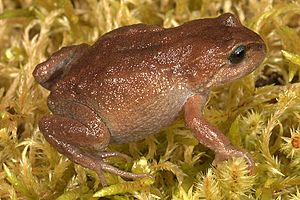Cusco Andes frog facts for kids
Quick facts for kids Cusco Andes frog |
|
|---|---|
 |
|
| Conservation status | |
| Scientific classification | |
| Synonyms | |
|
Phrynopus cophites Lynch, 1975 |
The Bryophryne cophites, also known as the Cusco Andes frog, is a special type of frog. It belongs to a group of frogs called Strabomantidae. This frog lives only in Peru. It is found on the slopes of a mountain called Abra Acanacu in the Cusco Region. Some people think it might live in other nearby mountains too, but this isn't fully confirmed yet.
Contents
What Does the Cusco Andes Frog Look Like?
Male Cusco Andes frogs are usually about 0.7 to 0.9 inches (18-23 mm) long. Female frogs are a bit bigger, measuring about 0.9 to 1.1 inches (22-29 mm) from their snout to their rear end. Their head is a little narrower than their body.
Their snout is short and rounded. These frogs do not have an eardrum that you can see. Their skin on top is a bit bumpy, and it gets rougher on their sides and belly. Their back legs are very short. They do not have any webbing between their toes.
The color of these frogs can be dull brown or light tan. Some have a mix of olive-brown and black, or brown and greenish-yellow or red. Their belly is a dull gray. Male frogs often have an orange color on their throat.
How Do Cusco Andes Frogs Have Babies?
These frogs have a unique way of reproducing called "direct development." This means their eggs do not hatch into tadpoles that swim in water. Instead, the babies grow directly into tiny froglets inside the eggs.
A female frog lays about 20 eggs. She then guards these eggs in a nest made of moss. When the eggs hatch, tiny froglets emerge. They are about 0.2 to 0.3 inches (6-7 mm) long.
Where Do Cusco Andes Frogs Live and How Are They Protected?
The Cusco Andes frog is a land-dwelling frog. It mostly lives in wet puna grasslands and special "elfin forests." These places are high up in the mountains, between 10,500 and 12,500 feet (3200-3800 meters) above sea level. Sometimes, they are also found in cloud forests, but they are very rare there.
This frog lives inside the Manú National Park. Even though they can be found in large numbers in good habitats, they are only known for sure from three places. Sadly, their home is being lost along the western edge of the park. This is happening because of cattle grazing and fires. One fire even caused a group of these frogs to disappear from their home.
A type of fungus called Batrachochytrium dendrobatidis has been found in these frogs. However, this fungus is not thought to be a big danger to frogs that have "direct development," like the Cusco Andes frog.
See also
 In Spanish: Bryophryne cophites para niños
In Spanish: Bryophryne cophites para niños


